Built Environment Professional Practice 1.
Added on 2023-03-17
38 Pages13548 Words29 Views
Built Environment Professional Practice 1
BUILT ENVIRONMENT PROFESSIONAL PRACTICE
Name
Course
Professor
University
City/state
Date
BUILT ENVIRONMENT PROFESSIONAL PRACTICE
Name
Course
Professor
University
City/state
Date
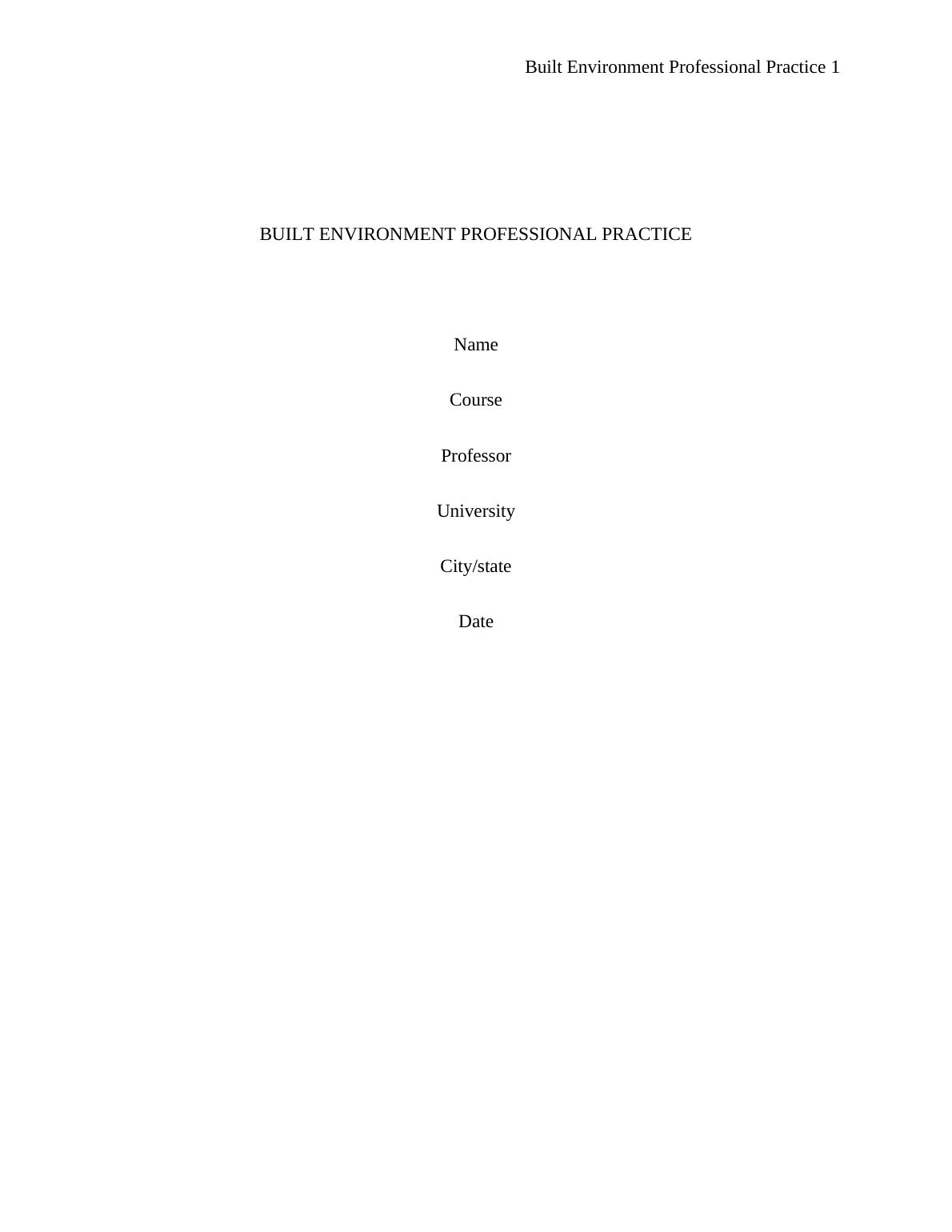
Built Environment Professional Practice 2
Table of Contents
1. Part 1: Team Organization...............................................................................................................3
2. Part 2: Procurement..........................................................................................................................5
2.1. Application of Planning Permit................................................................................................5
2.2. Building surveyor.......................................................................................................................6
2.3. Traditional and Non-traditional Procurement Methods........................................................8
2.3.1. Traditional procurement method.....................................................................................8
2.3.2. Non-traditional Procurement Methods............................................................................9
3. Part 3: Development Approval Letter/Report...............................................................................10
3.1. Proposed Development Brief and List of Attachments.........................................................10
3.2. Analysis of Existing Site and Surroundings...........................................................................11
3.3. State/Local Planning Policy.....................................................................................................13
3.4. Design Response.......................................................................................................................13
3.5. Explanation of Ambiguous or Contravening Elements.........................................................18
3.6. Heritage and Environmental Criteria....................................................................................18
4. Part 4: Construction Procurement.................................................................................................19
4.1. Contractual Process.................................................................................................................19
4.2. Construction Procurement Method........................................................................................22
4.2.1. Recommended Procurement Method.............................................................................22
4.2.2. Advantages of management contracting........................................................................25
4.3. Type of Building Contract.......................................................................................................26
4.3.1. Recommended Building Contract...................................................................................26
4.3.2. Advantages of Lump Sum Contract...............................................................................27
4.4. Roles and Risks........................................................................................................................30
4.4.1. Roles and risks of the client.............................................................................................30
4.4.2. Roles and risks of architect.............................................................................................31
4.4.3. Roles and risks of construction manager.......................................................................32
4.4.4. Roles and risks of contractor..........................................................................................33
References................................................................................................................................................35
Appendices...............................................................................................................................................39
Appendix 1: Organizational structure...............................................................................................39
Table of Contents
1. Part 1: Team Organization...............................................................................................................3
2. Part 2: Procurement..........................................................................................................................5
2.1. Application of Planning Permit................................................................................................5
2.2. Building surveyor.......................................................................................................................6
2.3. Traditional and Non-traditional Procurement Methods........................................................8
2.3.1. Traditional procurement method.....................................................................................8
2.3.2. Non-traditional Procurement Methods............................................................................9
3. Part 3: Development Approval Letter/Report...............................................................................10
3.1. Proposed Development Brief and List of Attachments.........................................................10
3.2. Analysis of Existing Site and Surroundings...........................................................................11
3.3. State/Local Planning Policy.....................................................................................................13
3.4. Design Response.......................................................................................................................13
3.5. Explanation of Ambiguous or Contravening Elements.........................................................18
3.6. Heritage and Environmental Criteria....................................................................................18
4. Part 4: Construction Procurement.................................................................................................19
4.1. Contractual Process.................................................................................................................19
4.2. Construction Procurement Method........................................................................................22
4.2.1. Recommended Procurement Method.............................................................................22
4.2.2. Advantages of management contracting........................................................................25
4.3. Type of Building Contract.......................................................................................................26
4.3.1. Recommended Building Contract...................................................................................26
4.3.2. Advantages of Lump Sum Contract...............................................................................27
4.4. Roles and Risks........................................................................................................................30
4.4.1. Roles and risks of the client.............................................................................................30
4.4.2. Roles and risks of architect.............................................................................................31
4.4.3. Roles and risks of construction manager.......................................................................32
4.4.4. Roles and risks of contractor..........................................................................................33
References................................................................................................................................................35
Appendices...............................................................................................................................................39
Appendix 1: Organizational structure...............................................................................................39

Built Environment Professional Practice 3
1. Part 1: Team Organization
As a team that has been mandated to assist in successful delivery of the retirement village
project, it was important to have a meeting so as to know each other better and establish some
ground rules. The following are the minutes of the intra-team organization structure meeting:
Retirement Village Project Team
Meeting Minutes
May 10, 2019
Opening
The first meeting of the retirement village project team was called to order at 9:00 AM in The
Abbotswood Motor Inn by the secretary of the team.
Present
All members of the team were in attendance.
Absent
None of the members was absent.
Approval of Agenda
The members unanimously approved the agenda of the meeting as it had been shared.
Business of the Meeting
Project Description:
The team facilitator comprehensively and briefly explained the project brief, scope, objectives,
deliverables, constraints/risks and milestones.
Task Distribution:
The team facilitator assigned every member of the team specific project tasks with timelines.
Organizational structure:
The team considered the project’s needs and selected project organizational structure as the most
appropriate option. This organizational structure is most suitable for large and complex projects;
brings together dedicated teams to achieve one common goal; enhances member’s project
management and technical skills; and ensures proper allocation and utilization of resources
(Harrin, 2018). The organizational structure is provided in Appendix 1.
The team also agreed that the project should be implemented through a joint venture (JV). This
organizational structure will bring together entities with the required capacity, resources and
expertise to complete the project successfully and share all risks and rewards (Famakin, et al.,
1. Part 1: Team Organization
As a team that has been mandated to assist in successful delivery of the retirement village
project, it was important to have a meeting so as to know each other better and establish some
ground rules. The following are the minutes of the intra-team organization structure meeting:
Retirement Village Project Team
Meeting Minutes
May 10, 2019
Opening
The first meeting of the retirement village project team was called to order at 9:00 AM in The
Abbotswood Motor Inn by the secretary of the team.
Present
All members of the team were in attendance.
Absent
None of the members was absent.
Approval of Agenda
The members unanimously approved the agenda of the meeting as it had been shared.
Business of the Meeting
Project Description:
The team facilitator comprehensively and briefly explained the project brief, scope, objectives,
deliverables, constraints/risks and milestones.
Task Distribution:
The team facilitator assigned every member of the team specific project tasks with timelines.
Organizational structure:
The team considered the project’s needs and selected project organizational structure as the most
appropriate option. This organizational structure is most suitable for large and complex projects;
brings together dedicated teams to achieve one common goal; enhances member’s project
management and technical skills; and ensures proper allocation and utilization of resources
(Harrin, 2018). The organizational structure is provided in Appendix 1.
The team also agreed that the project should be implemented through a joint venture (JV). This
organizational structure will bring together entities with the required capacity, resources and
expertise to complete the project successfully and share all risks and rewards (Famakin, et al.,
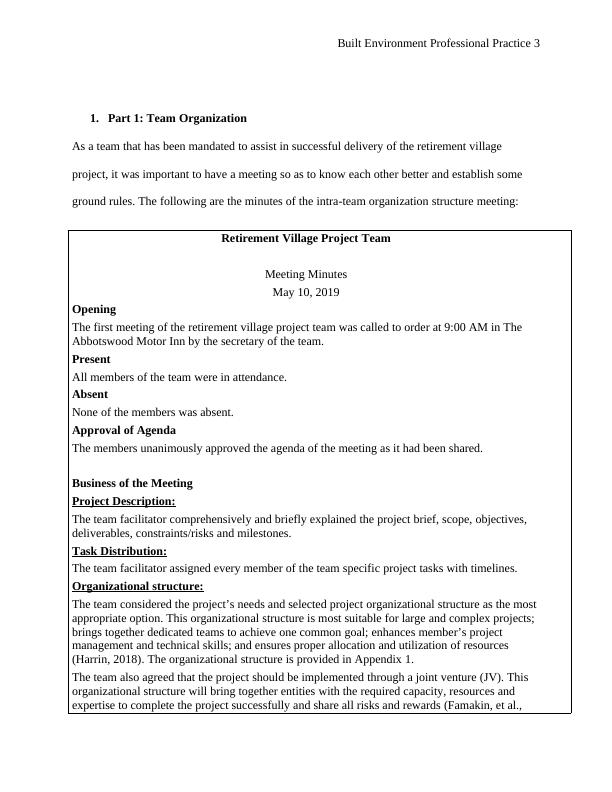
Built Environment Professional Practice 4
2012); (Tony & Voo, 2014). The team also discussed about various elements of a JV, including
number of entities, registration and accreditation requirements, software and hardware needs,
office location and size requirements, personnel, insurance, intellectual property, financial
contributions, management, dispute resolution and potential risks (Minja, et al., 2012); (Shen &
Cheung, 2018).
Resolutions/Outcomes:
The following are the resolutions and outcomes agreed upon by the team during the meeting:
i) The project is big and complex hence must be handled with the highest level of
professionalism.
ii) All stakeholders involved in the project must cooperate, collaborate, communicate effectively
and work as a team throughout the project period.
iii) The project should be executed using the latest technologies applicable in the construction
industry.
iv) The implementation of the project should be guided by the principles of sustainable
development.
v) The team will ensure that all activities are done in accordance with applicable engineering
standards building codes, regulations and works of practice.
vi) All team members will strictly adhere to the engineering code of ethics throughout the project
period.
vii) Any disputes between team members or other stakeholders must be resolved as quickly as
possible.
viii) The team will hold meetings weekly to discuss the progress of the project and any issues
arising.
ix) All activities must be done by qualified personnel and under close supervision.
x) Every decision made, action taken or any variations must be documented properly and shared
with all relevant stakeholders.
xi) The team must coordinate with relevant government authorities to ensure that relevant
approvals and permits are obtained and that all activities are done in accordance with the law.
Agenda for Next Meeting
Project stage/progress
Execution plan for each member’s assigned tasks
Requirements for formation of a JV
Issues identified
Adjournment
The meeting was adjourned by the team facilitator at 12:30 PM. the next meeting was scheduled
for May 24, 2019 at 9:00 AM in The Abbotswood Motor Inn.
Minutes submitted by: Secretary of the team
Minutes approved by: Team facilitator
2012); (Tony & Voo, 2014). The team also discussed about various elements of a JV, including
number of entities, registration and accreditation requirements, software and hardware needs,
office location and size requirements, personnel, insurance, intellectual property, financial
contributions, management, dispute resolution and potential risks (Minja, et al., 2012); (Shen &
Cheung, 2018).
Resolutions/Outcomes:
The following are the resolutions and outcomes agreed upon by the team during the meeting:
i) The project is big and complex hence must be handled with the highest level of
professionalism.
ii) All stakeholders involved in the project must cooperate, collaborate, communicate effectively
and work as a team throughout the project period.
iii) The project should be executed using the latest technologies applicable in the construction
industry.
iv) The implementation of the project should be guided by the principles of sustainable
development.
v) The team will ensure that all activities are done in accordance with applicable engineering
standards building codes, regulations and works of practice.
vi) All team members will strictly adhere to the engineering code of ethics throughout the project
period.
vii) Any disputes between team members or other stakeholders must be resolved as quickly as
possible.
viii) The team will hold meetings weekly to discuss the progress of the project and any issues
arising.
ix) All activities must be done by qualified personnel and under close supervision.
x) Every decision made, action taken or any variations must be documented properly and shared
with all relevant stakeholders.
xi) The team must coordinate with relevant government authorities to ensure that relevant
approvals and permits are obtained and that all activities are done in accordance with the law.
Agenda for Next Meeting
Project stage/progress
Execution plan for each member’s assigned tasks
Requirements for formation of a JV
Issues identified
Adjournment
The meeting was adjourned by the team facilitator at 12:30 PM. the next meeting was scheduled
for May 24, 2019 at 9:00 AM in The Abbotswood Motor Inn.
Minutes submitted by: Secretary of the team
Minutes approved by: Team facilitator

Built Environment Professional Practice 5
2. Part 2: Procurement
2.1. Application of Planning Permit
This project represents stage 6 & 7 of the larger retirement village development and a
planning permit must be obtained for the development of these stages to proceed. This means
that it is mandatory to apply for the planning permit as required by the relevant Australian
Standards including Building Regulations 2012, Building Act 2011, National Construction Code
(NCC) Building Code of Australia (BCA) and Planning and Environment Act 1987. The main
requirements for a planning permit include: site plans, elevation drawings and a written report.
The general procedure of applying for a planning permit is as follows:
Pre-preparation: it is important to find out more information about planning schemes
from Greater Geelong Council; discuss the proposal with the planning department of
Geelong Council (council planner) to be advised about the additional information that
must be provided when lodging the planning permit and the procedure for processing the
application; talk to the neighboring residents that may be affected by the project so as to
understand their concerns; and find a professional advisor for guidance (Victoria State
Government, 2018).
Preparing the application: this entails gathering the information that is required, filling
the planning permit application forms, and attaching relevant files. As aforementioned,
some of the requirements include: sketches, drawings (site plans, floor plans, elevations
and sections), photographs and a written report about different elements of the project
such as project description, estimated project cost, title information, owner’s consent,
impacts of the project (environmental, social and economic impacts), existing land use,
consistency or relevance of the proposed development to the natural setting,
2. Part 2: Procurement
2.1. Application of Planning Permit
This project represents stage 6 & 7 of the larger retirement village development and a
planning permit must be obtained for the development of these stages to proceed. This means
that it is mandatory to apply for the planning permit as required by the relevant Australian
Standards including Building Regulations 2012, Building Act 2011, National Construction Code
(NCC) Building Code of Australia (BCA) and Planning and Environment Act 1987. The main
requirements for a planning permit include: site plans, elevation drawings and a written report.
The general procedure of applying for a planning permit is as follows:
Pre-preparation: it is important to find out more information about planning schemes
from Greater Geelong Council; discuss the proposal with the planning department of
Geelong Council (council planner) to be advised about the additional information that
must be provided when lodging the planning permit and the procedure for processing the
application; talk to the neighboring residents that may be affected by the project so as to
understand their concerns; and find a professional advisor for guidance (Victoria State
Government, 2018).
Preparing the application: this entails gathering the information that is required, filling
the planning permit application forms, and attaching relevant files. As aforementioned,
some of the requirements include: sketches, drawings (site plans, floor plans, elevations
and sections), photographs and a written report about different elements of the project
such as project description, estimated project cost, title information, owner’s consent,
impacts of the project (environmental, social and economic impacts), existing land use,
consistency or relevance of the proposed development to the natural setting,

Built Environment Professional Practice 6
Submitting the application: the filled application form and all other necessary information
are submitted to the council offices after paying the application fee.
Assessment: the council will assess the application using a predetermined evaluation
criteria. Some missing information may be requested. The council will then advertise the
application for not less than 4 days so that people or groups that are likely to be affected
by the project may raise their concerns. The council will then consider any objections
raised and engage the applicant to respond or make necessary changes to the proposed
development (Victoria State Government, 2019).
Decision: the last step is for the council to approve the proposal and issued a planning
permit (which can be with conditions) or provide a refusal notice with reasons.
It is after obtaining a planning permit that the process of applying for a building permit will
begin. After getting the planning approval, the client and the project team must ensure that the
project is implemented as presented in the approval application documents. The council also has
a follow up plan to ensure that all regulations are followed failure to which will attract
fines/penalties or withdrawal of the planning and building permits or licenses.
2.2. Building surveyor
The person who should be mandated to apply for the planning permit and building permit is the
building surveyor. The main roles of a building surveyor include the following:
Assess the plans of the proposed development to ensure that they comply with the
requirements of the National Construction Code, Building Code of Australia, Building
Regulations 2018 and Building Act 1993.
Be responsible for the application of the planning and building permits of the proposed
development (Isnin, et al., 2016).
Submitting the application: the filled application form and all other necessary information
are submitted to the council offices after paying the application fee.
Assessment: the council will assess the application using a predetermined evaluation
criteria. Some missing information may be requested. The council will then advertise the
application for not less than 4 days so that people or groups that are likely to be affected
by the project may raise their concerns. The council will then consider any objections
raised and engage the applicant to respond or make necessary changes to the proposed
development (Victoria State Government, 2019).
Decision: the last step is for the council to approve the proposal and issued a planning
permit (which can be with conditions) or provide a refusal notice with reasons.
It is after obtaining a planning permit that the process of applying for a building permit will
begin. After getting the planning approval, the client and the project team must ensure that the
project is implemented as presented in the approval application documents. The council also has
a follow up plan to ensure that all regulations are followed failure to which will attract
fines/penalties or withdrawal of the planning and building permits or licenses.
2.2. Building surveyor
The person who should be mandated to apply for the planning permit and building permit is the
building surveyor. The main roles of a building surveyor include the following:
Assess the plans of the proposed development to ensure that they comply with the
requirements of the National Construction Code, Building Code of Australia, Building
Regulations 2018 and Building Act 1993.
Be responsible for the application of the planning and building permits of the proposed
development (Isnin, et al., 2016).
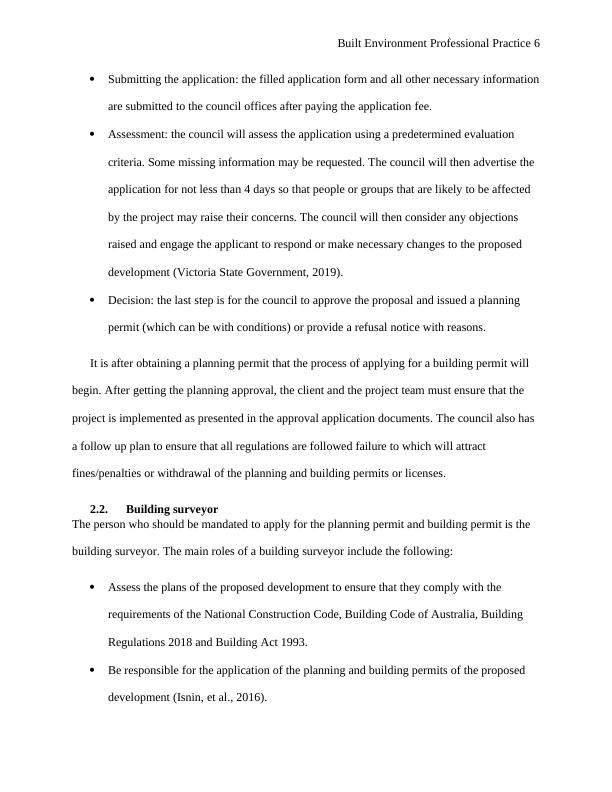
Built Environment Professional Practice 7
Ensure that the proposed development is easily accessible, safe, functional and resource
(energy and water) efficient.
Help in providing estimates of the proposed development by working in collaboration
with the architect, engineers and quantity surveyor.
Organize tendering documents and advice the client on appointing designers and
contractors and on procurement route (AGCAS, 2018).
Carry out feasibility studies of the proposed development.
Carry out inspections of the ongoing project so as to sign off each completed stage of the
construction.
Issue final inspection certificate or building and occupancy permit when building work is
complete.
Serve direction to fix when the building work does not comply with the relevant laws and
regulations.
Serve building orders and notices in accordance with the Building Act 1993 (Victorian
Building Authority, 2019).
Help in project management and budget monitoring during construction stage of the
project.
Oversees ongoing construction works on site and propose areas that can be improved so
as to minimize construction costs, and increase the speed of completion (Ali & Woon,
2012).
Offer quality assessments on building defects, identifies structural faults in a building and
recommend solutions for these problems.
Oversee the safety and health aspects of the development.
Ensure that the proposed development is easily accessible, safe, functional and resource
(energy and water) efficient.
Help in providing estimates of the proposed development by working in collaboration
with the architect, engineers and quantity surveyor.
Organize tendering documents and advice the client on appointing designers and
contractors and on procurement route (AGCAS, 2018).
Carry out feasibility studies of the proposed development.
Carry out inspections of the ongoing project so as to sign off each completed stage of the
construction.
Issue final inspection certificate or building and occupancy permit when building work is
complete.
Serve direction to fix when the building work does not comply with the relevant laws and
regulations.
Serve building orders and notices in accordance with the Building Act 1993 (Victorian
Building Authority, 2019).
Help in project management and budget monitoring during construction stage of the
project.
Oversees ongoing construction works on site and propose areas that can be improved so
as to minimize construction costs, and increase the speed of completion (Ali & Woon,
2012).
Offer quality assessments on building defects, identifies structural faults in a building and
recommend solutions for these problems.
Oversee the safety and health aspects of the development.
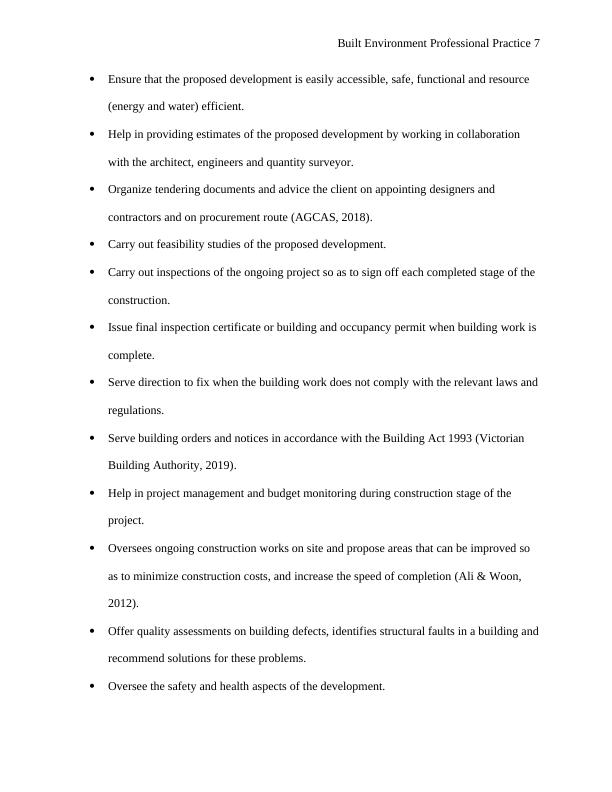
Built Environment Professional Practice 8
Monitor the general impacts of the development on the environment.
Can represent their clients or act as expert witnesses in contract and building disputes.
Prepare insurance evaluations and claims of the property.
2.3. Traditional and Non-traditional Procurement Methods
2.3.1. Traditional procurement method
This is the commonest and oldest procurement method in the construction industry. It is
where the client appoints consultants to prepare designs of the project and tender documentation.
Thereafter, contractors are invited to provide bids for the construction of the project. The client
uses a selection criteria to choose the most qualified contractor who is awarded the contract to
complete the construction works within stipulated time and budget (Johnsson, 2018). It is also
known as design-bid-build (DBB) procurement method or general contracting.
Advantages of traditional procurement method include: greater price certainty because
the designs of the project are completed and estimates made before awarding the contract;
greater flexibility because it allows variations and new instructions post tender; produces high
quality work because the client can ensure close supervision of construction works; the client can
select the contract with the lowest price via competitive bidding; and it is easier to adopt because
many stakeholders in the construction industry are familiar with it.
Disadvantages of traditional procurement method include: it is slower since construction
works commence only after the design work has been finalized; does not allow the contractor to
give his/her planning or design inputs that may improve the project’s buildability; project cost
may increase significantly if several changes are made to the project’s original design; it is
difficult to manage because the client deals with different entities; and has high chances of
disputes and conflicts.
Monitor the general impacts of the development on the environment.
Can represent their clients or act as expert witnesses in contract and building disputes.
Prepare insurance evaluations and claims of the property.
2.3. Traditional and Non-traditional Procurement Methods
2.3.1. Traditional procurement method
This is the commonest and oldest procurement method in the construction industry. It is
where the client appoints consultants to prepare designs of the project and tender documentation.
Thereafter, contractors are invited to provide bids for the construction of the project. The client
uses a selection criteria to choose the most qualified contractor who is awarded the contract to
complete the construction works within stipulated time and budget (Johnsson, 2018). It is also
known as design-bid-build (DBB) procurement method or general contracting.
Advantages of traditional procurement method include: greater price certainty because
the designs of the project are completed and estimates made before awarding the contract;
greater flexibility because it allows variations and new instructions post tender; produces high
quality work because the client can ensure close supervision of construction works; the client can
select the contract with the lowest price via competitive bidding; and it is easier to adopt because
many stakeholders in the construction industry are familiar with it.
Disadvantages of traditional procurement method include: it is slower since construction
works commence only after the design work has been finalized; does not allow the contractor to
give his/her planning or design inputs that may improve the project’s buildability; project cost
may increase significantly if several changes are made to the project’s original design; it is
difficult to manage because the client deals with different entities; and has high chances of
disputes and conflicts.
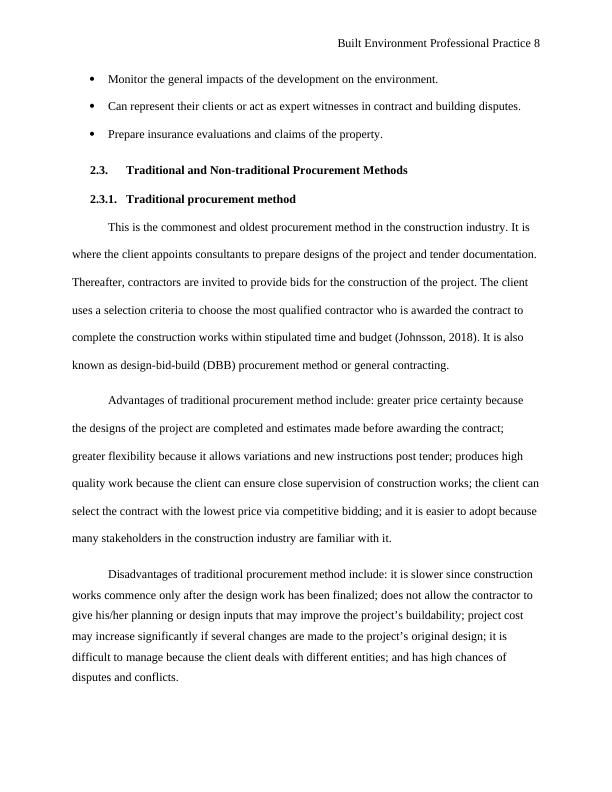
End of preview
Want to access all the pages? Upload your documents or become a member.
Related Documents
Built Environment Professional Practice (SRM750)lg...
|35
|8924
|30
Report on Management Principles in Construction Environmentlg...
|15
|3643
|45
Assignment on Ethics and Professional Practicelg...
|10
|3195
|98
Construction Practice and Managementlg...
|14
|3429
|464
Construction Practice and Management | Assignmentlg...
|17
|3836
|63
Project Management: Australian Property Managementlg...
|19
|3856
|175
